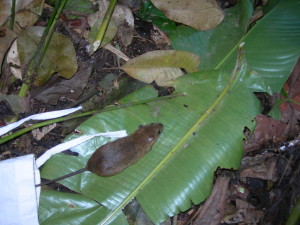When I started looking into rodent conservation, what I had expected to find was a tail of two species groups: 1) invasive, introduced rodent species dominating the natives, and 2) disappearing native species and simplified ecosystems as a result of habitat loss to human activities. It would appear, however, that the global situation is a bit more complex than that.

This rat lives in Bolivia’s rainforest- one question researchers have is how logging practices impact rodents in a habitat where travel between places is often by hanging vines
While there are plenty of stories about big bad black rats taking over whole ecosystems (and their effects also appear to linger- according to Jones (2010), New Zealand islands that had experienced rat eradication but no managed seabird recolonization had still not reverted back to pre-invasion nutrient cycling 7-10 year later), the rats may also have a positive contribution to make. We might prefer native species of rodent, but sometimes our development activities have already left those species high and dry. This can have effects that ripple throughout the ecosystem as important relationships break down. In the case of at least one fragmented ecosystem in Australia, however, the black rats that are quite happy to live in our developed landscapes may be able to step in and fulfill some of those lost ecosystem roles- Vernes and McGrath (2009) found that black rats fed on 24 taxa of fungus, making them potentially important spore dispersers in areas where the native dispersers have been extirpated. And black rats may not be as all-powerful as they seem. While investigating the degree and type of competition between black rats and bush rats in an Australian rainforest, Stokes et al. (2009) suggested that human-caused change in the ecosystem was what had given the black rats the initial invasion opportunity- once a rat removal program lowered black rat abundance, the bush rats were able to both increase their population and successfully defend their territories against black rats. This suggests that there are ways to make an ecosystem and a population more invasion resistant, which could be very important for preventing future species declines.
And rodent species are not just facing local habitat loss issues. Larger weather pattern changes are becoming a bigger problem, too. Decreased rainfall within Africa’s sahel means that more desert-like habitat, and the rodents that are adapted to those conditions, are pushing south (Thiam et al. 2011). These drier conditions have made things more difficult for the local rodent species, some of which are now in decline. This is not quite the usual invasive species scenario, since the desert rodents are moving with their habitat, nor is it the typical habitat loss story since the scale of the change is continental rather than local. An ocean away, researchers in Chile are concerned about the impact of stronger and more frequent El Nino events for arid environment rodents (Meserve et al. 2011)- since local species respond differently to periods of intense rainfall (depending on how long-lived they are- the longer-lived species wait until year 2 or 3 of high rainfall before populations start to jump, while shorter-lived species only respond in year 1), a change in frequency of high-rainfall years could really alter the rodent community. If we know more about the population dynamics of a species, we can better predict how they will respond to and whether they will survive an environmental crisis (Harris and Macdonald 2007).
In reading about more recent investigation into rodent populations around the world, I was struck by how individual each situation was– black rats invade and are bad, black rats invade and we can limit their impact, black rats invade and can be helpful, etc. So there is a lot of variation in the situation facing rodent populations and I think in the prognosis for their survival as well [Stokes et al. (2009) felt Australian bush rats could regain some of their ground with help in black rat removal, while Firth et al. (2010) predicted the brush-tailed rabbit-rat would be extirpated from Australia’s Northern Territory mainland within ten years due to habitat changes if conservation action wasn’t taken].
With so much still to learn about the issues facing, or caused by, rodent species, my guess is that there are also opportunities for us to get involved in the research and conservation efforts. In my final post of the month, I’ll look for ways to directly participate in the work being done.
Works cited:
Firth, RSC, Brook, BW, Woinarski, JCZ, and DA Fordham. 2010. Decline and likely extinction of a northern Australian native rodent, the brush-tailed rabbit-rat Conilurus penicillatus. Biological Conservation 143: 1193-1201.
Harris, DB and DW Macdonald. 2007. Population ecology of the endemic rodent Nesoryzomys swarthi in the tropical desert of the Galapagos Islands. Journal of Mammalogy 88: 208-219.
Jones, HP. 2010. Prognosis for ecosystem recovery following rodent eradication and seabird restoration in an island archipelago. Ecological Applications 20: 1204-1216.
Meserve, PL, Kelt, DA, Previtali, MA, Milstead, WB, and JR Gutierrez. 2011. Global climate change and small mammal populations in north-central Chile. Journal of Mammalogy 92: 1223-1235.
Stokes, VL, Banks, PB, Pech, RP, and DM Spratt. 2009. Competition in an invaded rodent community reveals black rats as a threat to native bush rats in littoral rainforest of south-eastern Australia. Journal of Applied Ecology 46: 1239-1247.
Thiam, M, Atteynine, SA, Traore, S, Duplantier, J-M, Maurel, D, and B Sicard. 2011. Capacity for water conservation in invasive (Gerbillus nigeriae) and declining rodents (Taterillus pygargus and Taterillus gracilis) that exhibit climate-induced distribution changes in Senegal. Journal of Arid Environments 75: 998-1007.
Vernes, K and K McGrath. 2009. Are introduced black rats (Rattus rattus) a functional replacement for mycophagous native rodents in fragmented forests? Fungal Ecology 2: 145-148.
